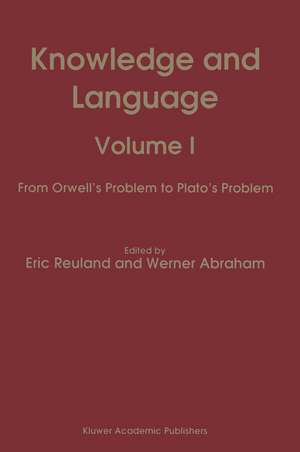Knowledge and Language: Lexical and Conceptual Structure
Autor F. R. Ankersmit, Conference on Knowledge and Language Editat de Eric Reulanden Limba Engleză Hardback – 31 mai 1993
Preț: 584.06 lei
Preț vechi: 687.13 lei
-15% Nou
Puncte Express: 876
Preț estimativ în valută:
111.77€ • 116.03$ • 93.20£
111.77€ • 116.03$ • 93.20£
Carte indisponibilă temporar
Doresc să fiu notificat când acest titlu va fi disponibil:
Se trimite...
Preluare comenzi: 021 569.72.76
Specificații
ISBN-13: 9780792317890
ISBN-10: 0792317890
Pagini: 284
Dimensiuni: 156 x 234 x 19 mm
Greutate: 0.58 kg
Editura: Springer
Locul publicării:Dordrecht, Netherlands
ISBN-10: 0792317890
Pagini: 284
Dimensiuni: 156 x 234 x 19 mm
Greutate: 0.58 kg
Editura: Springer
Locul publicării:Dordrecht, Netherlands
Public țintă
ResearchCuprins
Volume I 0. Introduction; E. Reuland, W. Abraham. 1. Reflections on Knowledge and Language; E. Reuland. 2. Mental Construction and Social Reality; N. Chomsky. 3. Some Reflections on our Sceptical Crisis; H. Bracken. 4. The `Least Effort' Principle in Child Grammar: Choosing a Marked Parameter; T. Roeper. 5. The Emergence of Bound Variable Structures; T. Roeper, J. de Villiers. 6. Categories in the Parameters Perspective: Null Subjects and V-to-I; M.R. Manzini. 7. Linguistic Theory and Language Acquisition Facts: Reformulation, Maturation or Invariance of Binding Principles; C. Jakubowicz. 8. Universal Grammar and Learnability Theory: The Case of Binding Domains and the `Subset Principle'; S. Kapur, B. Lust, W. Harbert, G. Motohardjono. 9. The Subset Principle is an Intensional Principle; K. Wexler. 10. Lexical Access and Speech Production; W.J.M. Levelt. Index. Volume II Introduction; E. Reuland, W. Abraham. Semantic Structures and Semantic Properties; B. Partee. The Combinatorial Structure of Thought: The Family of Causative Concepts; R. Jackendoff. Input Systems, Anaphora, Ellipsis, and Operator Binding; R. Kempson. Conceptual Structure and its Relation to the Structure of Lexical Items; J. Kornfilt, N. Correa. From Conceptual Structure to Syntax: Projecting from Resultatives; J. Carrier, J. Randall. Obligatory Adjuncts and the Structure of Events; J. Grimshaw, S. Vikner. Stage and Adjunct Predicates; T. Rapoport. Middle Constructions; T. Hoekstra, I. Roberts. Index. r/>
